The Enigmatic City: Lights and Shadows of the Strategic Enviromental Assesment
Keywords:
Evaluación ambiental, planificación urbana, gestión administrativaAbstract
The author feels that concern over widespread dwelling- patterns in human populations (involving the concentration of people in urban centres stems from our ignorance of their potential long and mid-term
consequences in every respect, be it social, economic or enviromental. The present paper attempts therefore to establish a basic rule, namely that urban growth should ever entail systematic mode of environmental assessment. That which is known as Strategic Environmental Assessment purposes precisely this and , through the employing of the same, the risks involved in planning human settlement could be made apparent. As every rule is open to err towards the dogmatic, the paper considers some
unfortunate spin-offs of the adopting of this mode that lead to tax-inequalities when it is applied by the public sector in territorial management. It is here felt that the policies from this mode derived often tend to drain off resources required to meet local specific responsibilities. The paper ends with a call for a reassessment of the existing structuring for administrative co-ordination.
Downloads
Downloads
Published
How to Cite
Issue
Section
License
Copyright (c) 2001 Juan Romano Velasco

This work is licensed under a Creative Commons Attribution-NonCommercial-NoDerivatives 4.0 International License.
Considering the provisions of the current legislation on Intellectual Property, and in accordance with them, all authors publishing in CyTET give -in a non-exclusive way and without time limit- to the Ministry of Transport, Mobility and Urban Agenda the rights to disseminate, reproduce, communicate and distribute in any current or future format, on paper or electronic, the original or derived version of their work under a Creative Commons Attribution-NonCommercial-NoDerivative 4.0 license International (CC BY-NC-ND 4.0), as well as to include or assign to third parties the inclusion of its content in national and international indexes, repositories and databases, with reference and recognition in any case of its authorship.
In addition, when sending the work, the author(s) declares that it is an original work in which the sources that have been used are recognized, committing to respect the scientific evidence, to no longer modify the original data and to verify or refute its hypothesis. Author(s) also declare that the essential content of the work has not been previously published nor will it be published in any other publication while it is under evaluation by CyTET; and that it has not been simultaneously sent to another journal.
Authors must sign a Transfer of Rights Form, which will be sent to them from the CyTET Secretariat once the article is accepted for publication.
With the aim of promoting the dissemination of knowledge, CyTET joins the Open Journal Access (OA) movement and delivers all of its content to various national and international indexes, repositories and databases under this protocol; therefore, the submission of a work to be published in the journal presupposes the explicit acceptance by the author of this distribution method.
Authors are encouraged to reproduce and host their work published in CyTET in institutional repositories, web pages, etc. with the intention of contributing to the improvement of the transfer of knowledge and the citation of said works.








 Enlace a CyTET en Linkedin
Enlace a CyTET en Linkedin